Generation 1: Alden L. Hatheway, the California Immigrant
From the Hoffman point of view, the Hatheway line starts with Alden Leonard Hatheway. Born 1839 in Freetown, Massachusetts, he moved to the Bay area around 1858 and settled in Vallejo, California in 1872.
A local Vallejo newspaper published a very comprehensive obituary in 1901 that captures the life of our Alden. Read it below for a great summary.
While this obituary covers the basics, you can find all kinds of interesting details if you poke around the internet. Included below are two additional published accounts. They start with the California gold rush of 1849 when Alden, aged 10, would have witnessed a dramatic transformation of his hometown in Freetown.
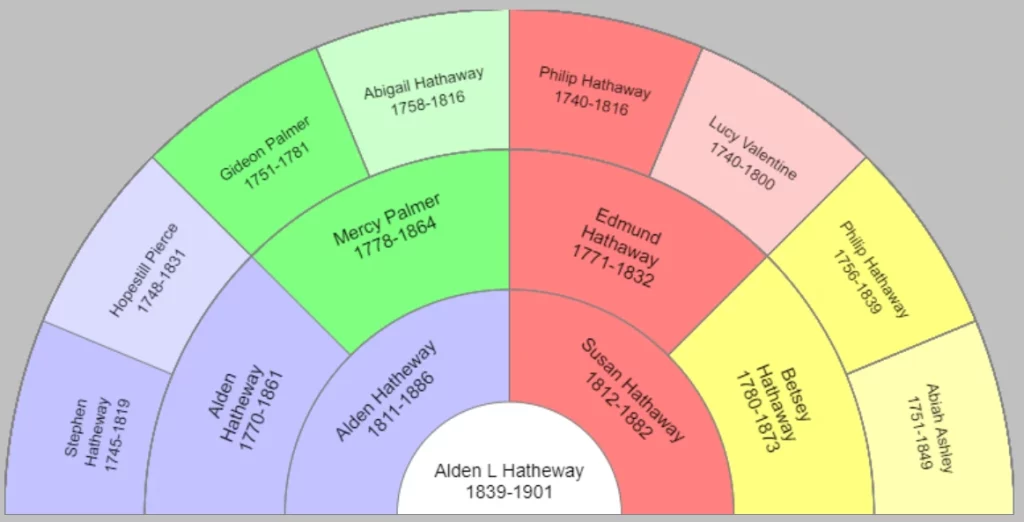
From “The Solano-Napa News Chronicle”, 3 Dec 1901 (newspapers.com)
“Mr. Hathaway was a native of Massachusetts, aged 62 years, and came to this coast when about 19 years of age. His first employment was as time keeper for his uncle on Hathaway’s wharf in San Francisco. Later he was employed in Marin county, and then at Suscol. In 1871 he came to Vallejo and was given the position of Chief Clerk in the Steam Engineering Department at the Navy Yard, that department then being in charge of his cousin, chief engineer Elbridge Lawton. He held that position until 1888, when he was superseded by William Tormey, but at the end of a year he was given back his old position, which he held until about seven years ago, when he was succeeded by James Brady. Since his retirement from the Navy Yard he has conducted a profitable real estate and insurance business, and was also agent for the Farnham estate. He was a member of the A.O.U.W., of the Knights of Pythias, of Vallejo Lodge, No. 75, F. and A.M., and of Solono Lodge No. 229, F. and A.M., and was last night elected Secretary of the latter lodge. Mr. Hathaway was married 29 years ago to Miss Fannie Watson of the city, five sons being the fruit of this union, and all surviving with their mother to mourn his loss.”
From “A History of the town of Freetown, Massachusetts : with an account of the Old Home Festival, July 30th, 1902″
Soon after the discovery of gold in California in 1849 nearly seventy of our citizens, mostly young men, went there in search of the precious metal. Not all found and retained it in liberal quantities. This rapid emigration to California was a striking feature of the times. HS ships, 87 barks, 41 brigs and 15 schooners, or 151 vessels in all cleared from the port of Boston, for California in one year following the discovery of gold in that state. Thousands who left their homes with high expectations of sudden wealth soon learned that “all is not gold that glitters,” and that “most that is good is not gold.” The town has never fully recovered from the disheartening effect of this sudden and severe drain upon its young manhood. The following is Freetown’s list of [Hathaway] ’49ers: Barnaby W. Hathaway, Benjamin Hathaway, Charles W. Hathaway, Edmund D. Hathaway, Edmund V. Hathaway, Elias Hathaway, Gideon P. Hatheway, Guilford Hathaway, John Hathaway, Valentine Hathaway
From “The Fall River Herald News”, 17 Oct 1978 (sailinc.org)
One of the greatest adventures was had by three brother, Edmund D., Charles W. and Dr. Edmund V. Hathaway. From Panama they took a ship to Monterey, where Charles and Edward paused to vote for delegates of the constitutional convention. From Panama to California took three months. Giving up prospecting after a few weeks, they went into the commission and warehouse business in San Francisco. The physician returned, taking up practice in Providence. Then he rejoined the duo in California. They became rich building wharves and warehouses; incorporated the first marine insurance company in the new state; and inaugurated the Republican Party there with 97 friends. Charles was elected to municipal government and was on the famous Vigilance Committee.
Let’s try to summarize these articles. Alden’s uncles, Dr. Edmund V. Hathaway and Charles W. Hathaway, made a lot of money in the wharf and warehouse business in San Francisco. They had the capital and experience necessary for success since they came from an affluent family involved in the ship building business in Freetown. The third brother was likely Valentine who bought land in Suscol, Napa county. If Edmund D. Hathaway came here, he would have been a bit player.
Click here to read the crazy story about the Hathaways in the Vigilance Committee. The video below has a different perspective of this group.
The Vigilance committee, up to 5,000 strong, formed to combat perceived corruption and lawlessness of the young city of San Francisco. Among their many actions, they spearheaded the hanging of Casey and Cora, two men guilty of murder. Although the committee lasted only a few months, it changed the dynamics of San Francisco politics for many years. The article above names C.W. Hathaway as a member of the Vigilance Committee, but E.V. Hathaway proudly takes credit in his obituary:
He [Dr E. V. Hathaway] became a prominent figure in the stirring Affairs of San Francisco’s early days. As a member of the Vigilance Committee of 1856 he served as gun captain in charge of the piece of artillery with which the citizens threatened to batter down the jail door unless Casey and Cora were delivered to them. Dr Hathaway himself held the burning fuse over the cannon while demands were being made for the prisoners. He wrote an account of his recollections of the affair. He says: “We took the gun from Macondray’s store, hauled it to Broadway, took position opposite the jail and demanded Casey and Cora. The gun was trained on the jail door, and I myself held the burning fuse, ready to fire should the man not give up.The surrender of the men and their subsequent hanging on Sacramento Street is a matter of history.” (obituary of Dr. Edmund V. Hathaway in the San Francisco Chronicle, 12 Dec 1899)
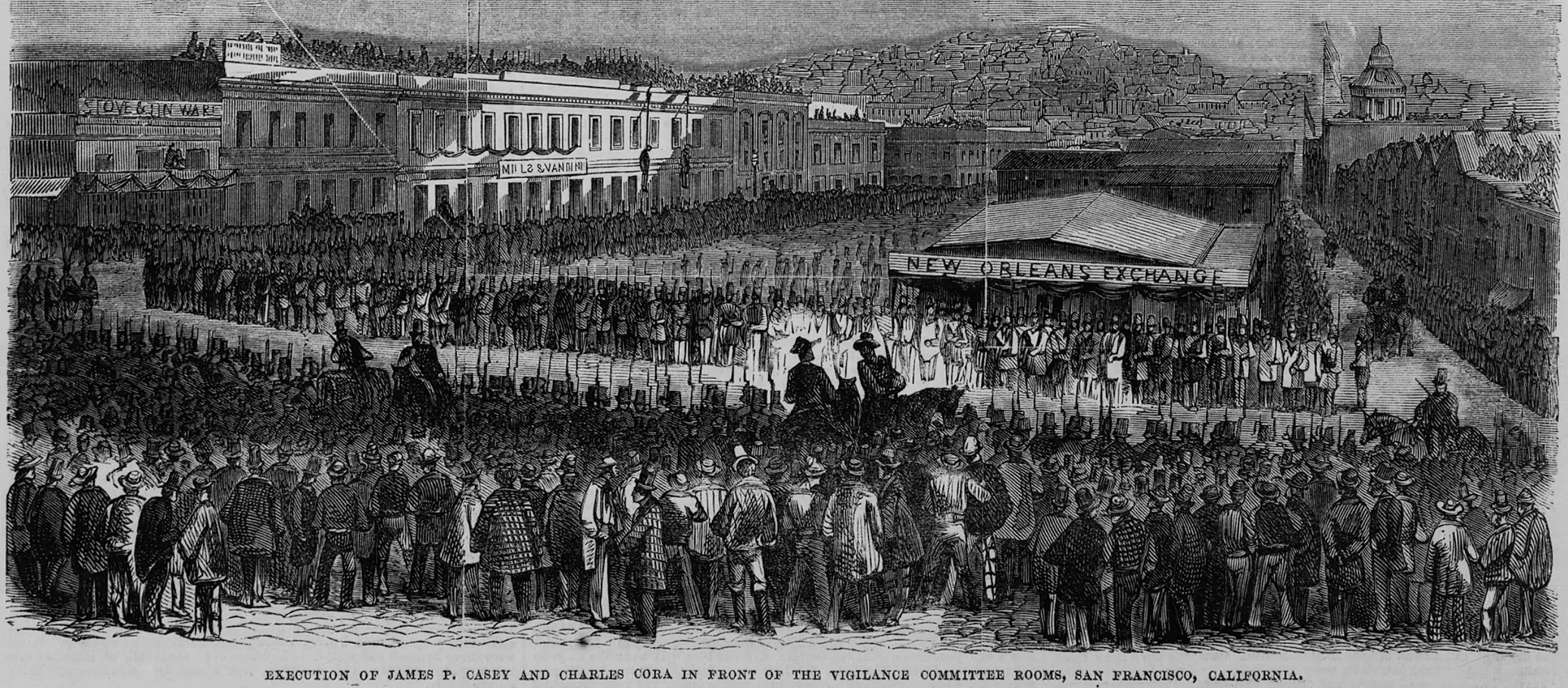
Alden likely arrived in San Francisco at the same time as Edmund’s two sons, E.V. and Guilford, as part of a second Hathaway wave. Alden and E.V, both 21, roomed together in the 1860 census, a few years before the start of the Civil War. Although Californians sided with the Union, San Francisco had a large percentage of relocated Southerners. The Union leaders worried about a Confederate force attacking California to seize its gold. So armies were organized within California. Alden joined the National Guard. He eventually rose to the rank of Lieutenant.
Alden worked at Hathaway and Co, owned by uncle C.W. Hathaway. He got promotions from book keeper to salesman before taking over the consignment part of the business. A year later he left the business, likely forced out. Alden mysteriously drops out of sight for the next five years with no city directory or newspaper references.
History of San Francisco: Birth of a City, Part 1 (1999), narrated by the smooth voice of Peter Coyote
use the slider or arrow keys (“<” and “>”) to skip to correct time
The Vigilance Committee 13:29 – 15:13
The Capitalist Class in San Francisco 15:14 – 16:22
San Francisco when Alden Hatheway arrived 17:56 – 19:16
San Francisco and the Civil War 19:37 – 21:28
Influx of Irish Immigrants 21:48 – 23:19
By the time of the 1870 census, Alden is living in the Olema Hotel working as a laborer in that small Marin county locale. According its history, “In the 1870s, Olema was a raucous and booming dairy town.” How did he get there? It turns out, you can see the another cousin, Guilford, living in Olema in the 1860 census with 2 horses, 30 milk cows and 20 other cattle. He left for Prescott, Arizona in 1863. Maybe Alden took control of the livestock.
Suscol also gets a mention in Alden’s obituary. Here’s where Alden’s uncle Valentine lived. He ran the dock at Suscol crossing, the preferred place to move goods into the Napa region. However, as the expansion of the railroad affected this business, Valentine focused on farming his large plot of land in the nearby rolling hills. He and Alden must have forged a close relationship. Alden named a son after him. In return, Valentine left his namesake $5,000 in his will (approximately $160,000 in today’s dollars).
Then cousin Elbridge Lawton came to the area in 1871-1876 as chief engineer at Mare Island. Alden secured a position through him as Clerk in the Steam Engineering Department. His marriage to Frances Beatrice (Fannie) Watson followed soon after in 1872. From this time forward, you can find a lot of mention of Alden in the Vallejo newspapers. You see him associated with those fraternal organizations. He was also very active in the Republican party. He actually ran for office a few times, never winning. His job must have involved political patronage. He got fired in 1888 as “the last Republican clerk on the yard.” at the end of the first term of Grover Cleveland, a Democrat. Then he was reinstated in 1889 after the Republican Benjamin Harrison served from 1889-1993. He got fired again in 1893 after Grover Cleveland regained the presidency. After his Mare Island job, Alden began a new career in insurance and real estate which give him now daily mentions in the Vallejo newspapers. He remained active up his death on 3 Dec 1901 at the age of 62. The family lived in a nice house at the top of the hill on Carolina St which was replaced by a ATT switching station in the 1940’s.
Click here to read the newspaper details of Alden’s hiring and firing
- Orders were received on the Mare Island Navy Yard on Friday removing A.L. Hathaway, Chief Clerk in the Steam Engineering Department, and appointing William Tormey to the vacancy. The change goes into effect March 1st. Hathaway was the last Republican clerk on the yard. (from “The Sacramento Bee”, 25 Feb 1888)
- The first clerical change at the Mare Island Navy Yard under the present administration was made April 13th. A. L. Hathaway, former chief clerk in the steam engineering department, received his old position. This removed William Tormey. Hathaway was the last clerk removed by the Cleveland administration. (from “The Napa Register”, 19 Apr 1889)
- VALLEJO, Nov. 9. – Political decapitation was revived to-day, and by direction of Secretary [of the Navy] Herbert the following clerks were removed for offensive partisanship: A. L. Hatheway, chief clerk of steam engineering department, $1,400 a year; A. Burnap, chief chemist, $1,400 a year, C. Foster, clerk, $1,000 a year. (from “The Woodland Daily Democrat”, 11 Nov 1893)
- Oakland, November 20. – Ex-City Clerk J.M. Brady has been appointed Chief Clerk in the Bureau of Steam Engineering at the Mare Island Navy Yard. His predecessor, A. L. Hathaway, held the position for over twenty years. (from “The San Francisco Examiner”, 21 Nov 1893)
Regarding his children: Alden Leonard Hatheway (1875-1940) worked at Mare Island as a patternmaker, married Annie Fitzmaurice, and had four girls. Elbridge Lawton Hatheway (1877-1959) worked at maintenance departments at Mare Island and Sonoma State Hospital, married, had one child, no descendants. Noah (1881-1920), who rose to the position of Vallejo City Treasurer, died as single young man from a accidental gun mishap. Valentine Hatheway (1887-1969) worked various jobs in the East Bay, married and left 8 grandchildren when he died. Walter Duncan Hathaway (1890-1890) died as an infant. Gerard Leonard Hatheway (1895-1956) worked various office jobs, married briefly, had no children.
Generations 2-3: Prominent Freetown Hathaways
Alden’s parents were Alden Hatheway Jr and his wife Susan Hathaway. Both came from well-to-do families. During the turn of the 19th century, it was common for books to be written about the history of various locales. The books would include essays on its prominent citizens. Alden got his biography along with a nice sketch. In the case of Susan Hathaway, we can learn about her side of the family from the biography of her brother. The story of Susan’s mother, Betsey Hathaway, and her grandmother, Abiah (Ashley) Hathaway, comes from the Ashley family newsletter. A lot of these organizations existed before the internet. They would be run by a few motivated family members. Sometimes a family reunion would be held. It all seems so quaint.
Generation 4: The Revolutionary War Ancestors
The citizens of Freetown, and particularly, Assonet, appeared quite conflicted about involvement in the Revolutionary War. It was a wealthy ship building enclave that did not want to rock the boat (pun intended). The British felt secure in Assonet and had organized troops with a large cache of weapons. However, an angry mob from Taunton drove them away prior to events at Lexington and Concord in April 1775. Eventually, the town issued a statement in support of the revolution in February, 1776. Yet divisions remained. In May, 1777, 26 Freetown men stood trial for supporting the enemy. Names included three Hathaways and an Ashley – all surnames on the fan chart. Fortunately, Alden L. Hatheway’s four great grandfathers all served honorably. There were Stephen Hatheway b. 1745, Gideon Palmer b. 1751, Rev. Philip Hathaway b. 1740 and Philip Hathaway b. 1756. One of the Philips even signed that pro-war statement.
The British had established a beachhead in Newport in December, 1776 after their rout of George Washington in New York. The colonist maintained their own fortification in Tiverton to monitor the British operation and minimize its threat. The redcoats would conduct occasional raids (stealing food, burning ships, destroying bridges, etc). One of these attacks included Freetown in May, 1778. In August, 1778 the colonialist with help from the French fought the British to a draw in Rhode Island’s lone battle. The British left Newport in Oct, 1779.
The Revolutionary War had minimal impact on the Hathaway men. It likely involved manning the fortification at Tiverton or running to Rhode Island on alarm to repel a raid. Rev. Philip was able to build a house in 1782 soon after the war. Philip Hathaway b. 1740 lived long enough to receive a pension. His application gives more detail about his service for those interested. The DAR (Daughters of the American Revolution) recognizes the service for these three, so it would be relatively easy to join this society based on any of their services.
Click here to read the details of service in the book “Mass Men in the Revolutionary War”
- HATHAWAY, PHILIP, Jr. 1st Lieutenant, Capt. Benjamin Read’s (4th) co., 2d Bristol Co. reg of Mass. militia; list of officers chosen in said regiment, as returned by Edward Pope and others, field officers, dated April 5, 1776; ordered in Council, April 26, 1776, that said offers be commissioned; reported commissioned April 26, 1776.
- HATHAWAY, PHILIP. Freetown. Lieutenant, Capt. Elijah Walker’s co., Col. John Hathaway’s regt.; service, 21 days; company marched from Dighton to Tiverton, R.I., April 23, 1777. Roll sworn to at Taunton.
- HATHEW’Y, STEPHEN. Private, Capt. Abel Babbit’s co., Col. John Hathway’s regt.; enlisted Aug. 1, 1780; discharged Aug. 7, 1780; service, 7 days; company marched to Rhode Island on an alarm.
- PALMER, GIDEON. Master’s Mate, ship “Protector,” commanded by Capt. John Foster Williams; engaged Sept. 20, 1780; returned July 20, 1781; service, 10 mos
Gideon Palmer deserves special mention since he apparently died while serving. In her 1905 DAR application, Miss Mercy Maria Hathaway tells the story as:
“Gideon Palmer, (1751-1781) was master’s mate of the “Protector,” commanded by Capt. John F. Williams. He was born in Little Compton, R.I., and died Dartmoor Prison, England.”
Being the great grandchild of Gideon Palmer, you would think Mercy Maria Hathaway would be pretty accurate. However, looking at the record with today’s internet tools, you find an inconsistency in that Dartmoor prison did not exist until 1810. Gideon Palmer’s ship, the Protector, had some early success against the British prior to its capture on May 5, 1781 by the Naval ships HMS Roebuck and HMS Medea. The crew of the Protector, including John Fuller Williams, where taken to the Jersey, a British prisoner ship anchored off Sandy Hook. The Jersey ship manifest (found in London archives) names a total of 127 captured men. Gideon Palmer does not show up on this list. Ebenezer Fox, a shipmate of Gideon, wrote a book in 1832 about his time on the Protector and the Jersey. He indicates that “about a third part of our ship’s crew were taken on board of their vessels, to serve in the capacity of sailors, without regarding their remonstrances.” Next step would be to check the manifests of the Roebuck and Medea.
No official record explains the circumstances of Gideon Palmer’s Revolutionary War death. The Massachusetts book, “Mass Men in the Revolutionary War” states cryptically that he “returned July 20, 1781”, two months after the Protector’s May capture. Unofficially, however we have a photo of the needlework sampler from Gideon’s daughter, Mercy. It poignantly tells us that he died in 1781. Ironically, Gideon Palmer’s service is no longer officially recognized by the DAR. Early records were riddled with errors, so the DAR developed a higher bar for acceptance. Someone will need to reapply under his name to get him back on the their rolls.
Generations 5-9: The Puritan Ancestors
The Hatheway line can be traced all the way back to the initial settling of this county from England. Increasing Alden’s fan chart to 8 generations shows the extent of these individuals. Rarely does one see a tree this full. Alden’s ancestors were Puritans who remained in the Freetown area of Massachusetts until Alden L Hatheway left for California.
The Puritans represented the first big wave of immigrants to North America. As many as 20,000 arrived between 1620 and 1640 and settled in the Massachusetts Bay Colony. The Puritans followed a form of Protestantism that viewed their motherland’s Church of England as too “Catholicly”. They negotiated a Charter with the King that allowed them to travel to North America to practice their religion. In exchange, they remained loyal to the crown. This immigration wave ended with the Civil War in England.
Puritans have a well deserved reputation of being very strict and intolerant. They did not celebrate holidays, and they did, in fact, hold a few trials for witchery. Yet we owe them a big thanks. Each town revolved around the church which kept excellent records. As a result, a very rich history has been left to us stodgy bluebloods. The New England Historic Genealogical Society (NEHGS) has a effort to document all the Puritans as part of their Great Migration Study Project. Of all the various Puritans, Nicholas Hathway (generation 9) merits special mention. We consider him as the progenitor, the first of their name to set foot on American soil. Ironically, he did not leave behind much of a record in Massachusetts. He arrived from London to Dorchester around 1638, and settled in Braintree with son John.
Beginning in the early 1900’s, interest in genealogy and these Puritan church records resulted in numerous books written about the various progenitors. The researcher would write people across the country to see how they related. Then they compiled the results into a book. You might pay a publisher to print a few hundred copies for family and libraries before you joined your ancestors. Most of these books are off copyright so you can read them for free on websites like archive.org.
The Hatheway researchers took several generations to publish three different versions of “The Hathaways of Americas”: (1) 1965 initial edition published in 1965 at 621 pages, (2) the 1970 magnus opus at an astounding 1426 pages and (3) the 1980 supplement at 621 pages. Alden Hatheway gets a mention in the 1970 and 1980 books. Only the supplement looks to be available online at this time due to copyrights, but I included a link to the Alden Hatheway page from the 1970 book.

Generation 8: The Mayflower Ancestor
Dick Hoffman convinced himself that he had a Mayflower connection with the Hatheways. He wrote a few letters to the Mayflower Society making his case. Each time, he received a kind “no”. The Society has strict criteria for entry. You have to use persuasive evidence for each generation to convince their certified genealogist. Fortunately, the Mayflower Society does give you some big assistance. First, they have published a series of books covering all the original Pilgrims containing the first five generations of descendants. They accept these individuals as fact, so you don’t have to do the work. Second, if you can find a tree of a verified member, you can couple yourself into their tree. In the end, you must prove those generations unique to your application.
Why so much talk about this topic? Because if you look at the fan chart, you can see a branch of individuals mentioned in one of the Mayflower books. The most recent person is Abiah Ashley (1751-1849) shown in light yellow. Her biography can be seen above. Her Mayflower ancestor is Thomas Rogers. There is a website dedicated to him where you can read more. If Dick had only considered the women in his Hatheway line, you would have easily found his Pilgrim.
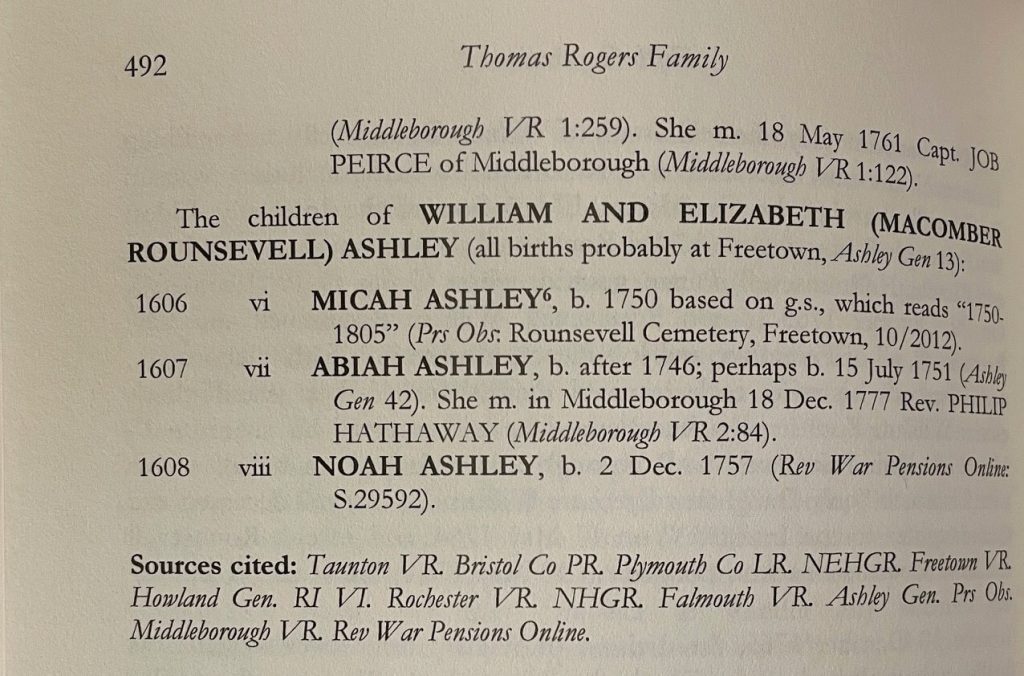
While researching this essay, another link to Alden Hatheway’s illustrious past came to light. As we all know, the Marga Carta, signed in 1215, put in place a set of rules that formed the basis of our system of laws today. Alden’s Ancestor, Simon Lynde (light red in fan chart), represents the gateway to Robert de Vere. He was one of 25 barons who pledged to uphold the terms of the Magna Carta against John, the King of England. These records survived because the family remained part of the nobility which tended to write about their greatness. You can read more about this organization in the link below.
DNA Results
Alden L. Hatheway was born to Alden Hatheway and Susan Hathaway. Although related, their relationship is not as close as their last names imply. They are 2nd cousins one time removed by way of Meletiah and Anna (Hoskins) Hathway (seen in light green and dark yellow in the fan chart). However, both Alden and Susan were related through two additional pathways: 3rd cousins by way of Henry Hoskins and 4th cousins by way of John Hathway Jr. To further complicate things, Susan Hathaway was born to Edmund Hathaway and Betsy Hathaway. They were second cousins by way of Jacob and Phillipa (Chase) Hatheway (dark red and dark yellow).
This makes DNA analysis more difficult because the DNA of Alden L. Hatheway’s ancestors comes from several pathways. For example, Alden get the DNA of Meletiah Hatheway from both his mother and father. The phenomena is called pedigree collapse because the number of ancestors is smaller than expected. It causes the DNA matches to be magnified. In order words, the amount of shared DNA with other relative increases because this shared DNA comes from multiple pathways. You can also see this phenomena in Ancestry’s Thrulines which combine user’s posted tree with the DNA results. There are are huge number of matches that exist for earlier ancestors, significantly more than would be expected.
One the other end of the spectrum is the DNA of the Alden Hathaways. The thruline for Stephen & Hopestill Hatheway shows 6 branches including the first Alden b. 1770. However, neither Alden b.1811 nor Alden b. 1839 show any branches even though they both likely have living descendants. It could mean that no one has tested. Or that shared DNA does not pass the minimum threshold of 8 cM. Or it could be an indication of an NPE (Non Paternal Event), otherwise known as a shenanigan where the DNA and the written record diverge.
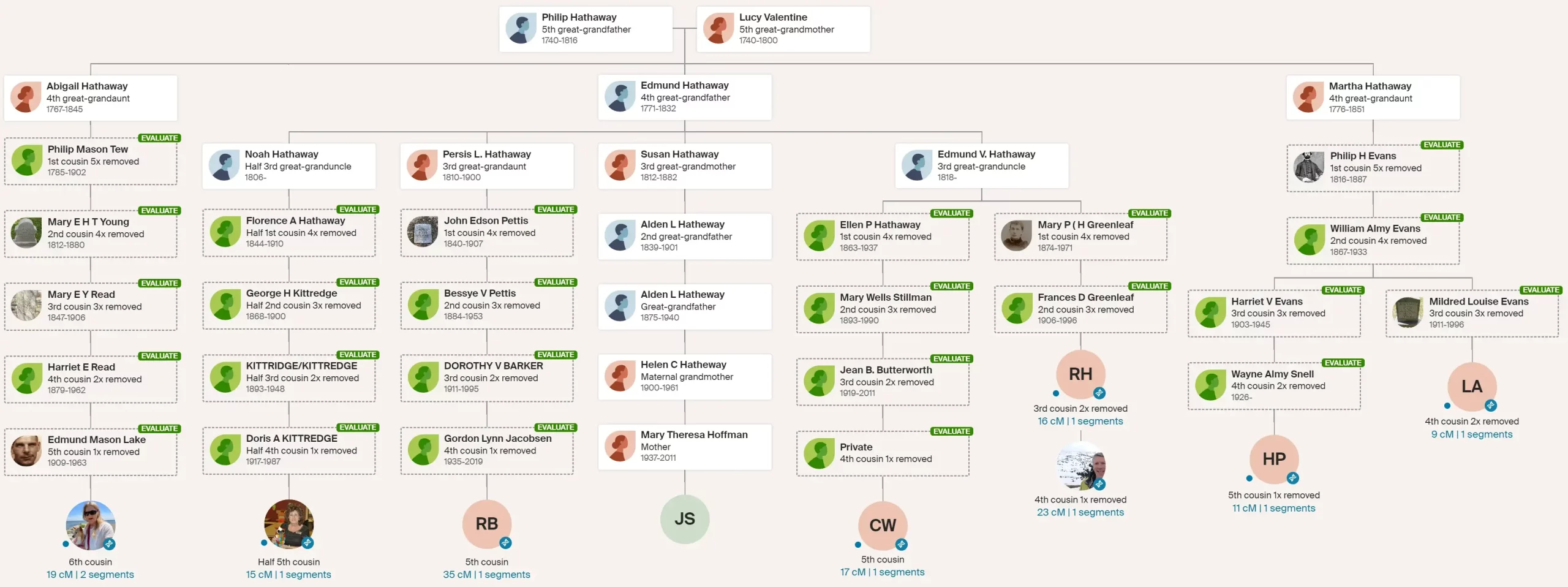
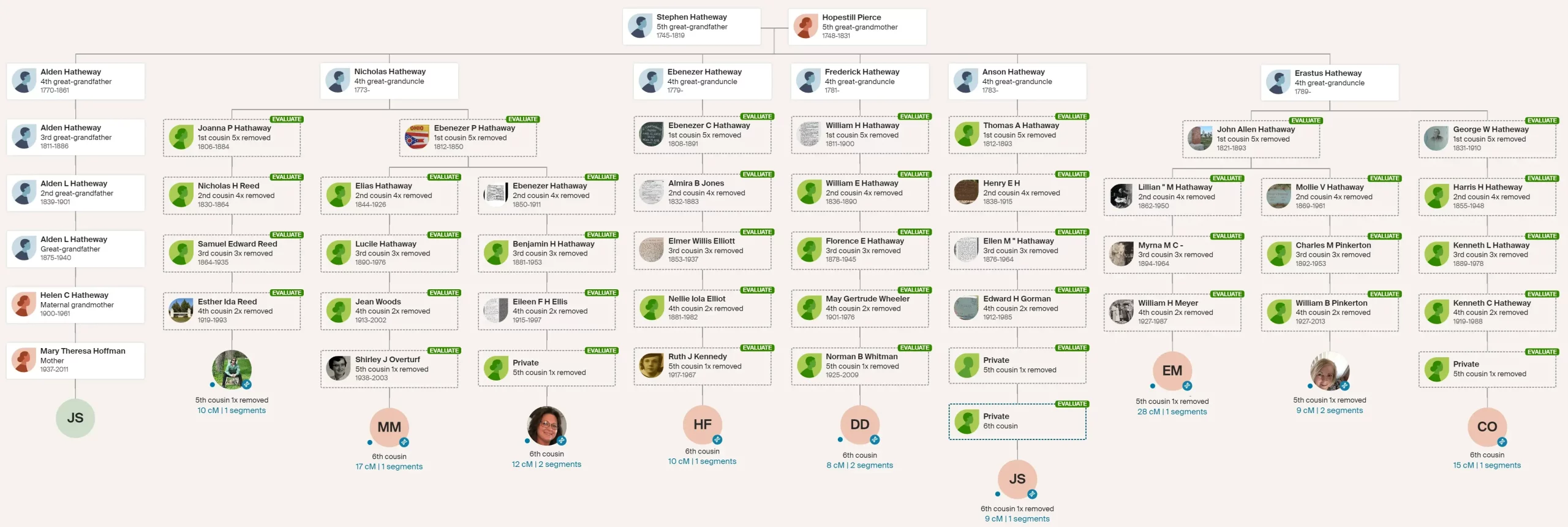
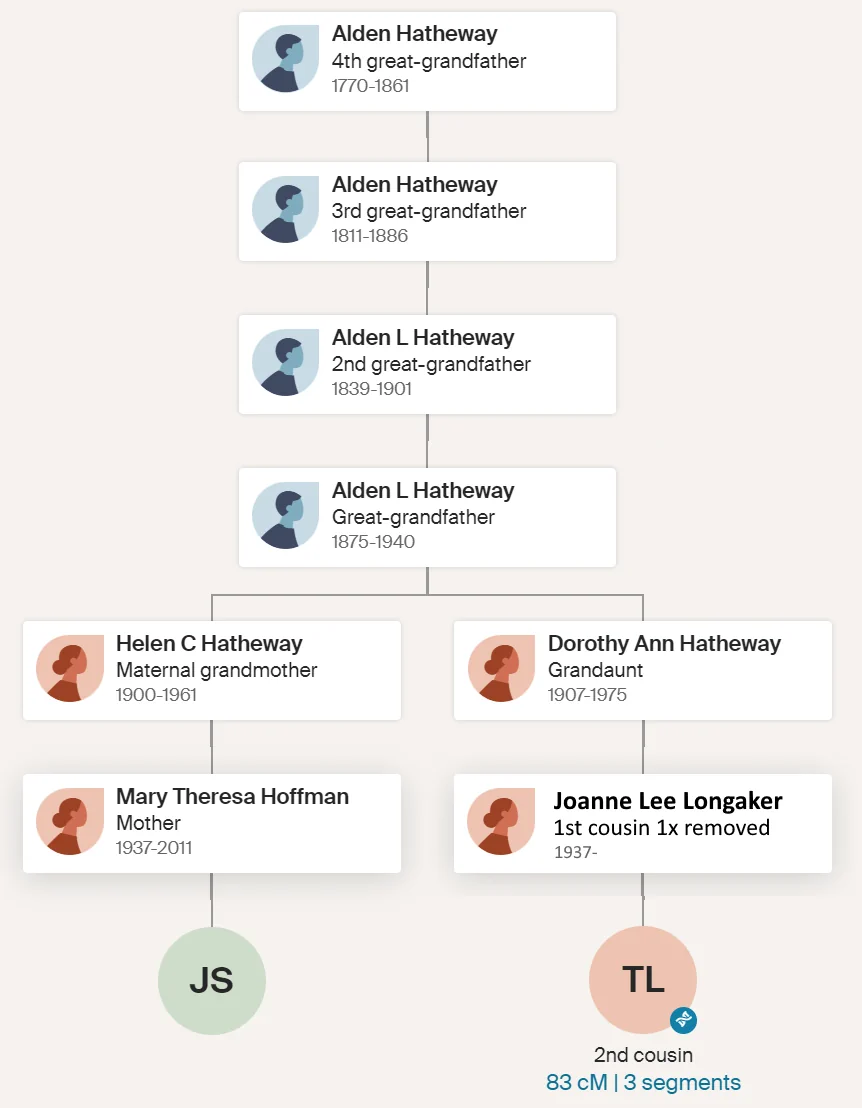
Conclusion
There you have it. Hathway/Hathaway/Hatheway from 1600 to the present. Fortunately, male descendants of Valentine Joseph Hatheway carry on the Hatheway name. We can look forward to more Hatheway based stories in to the future.
